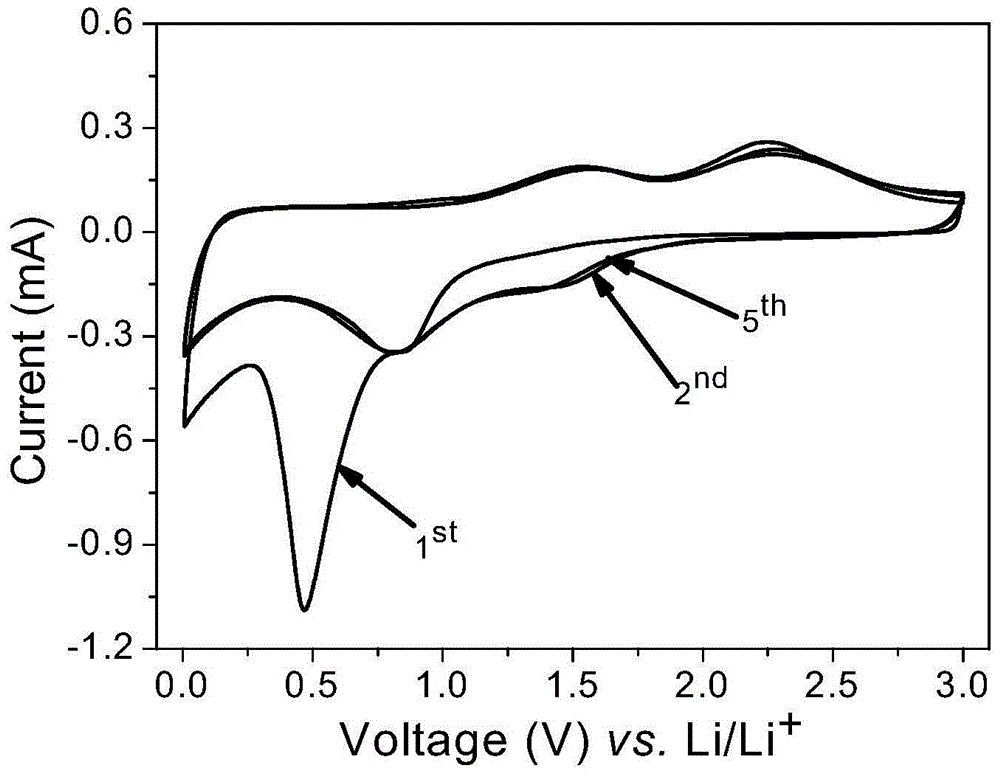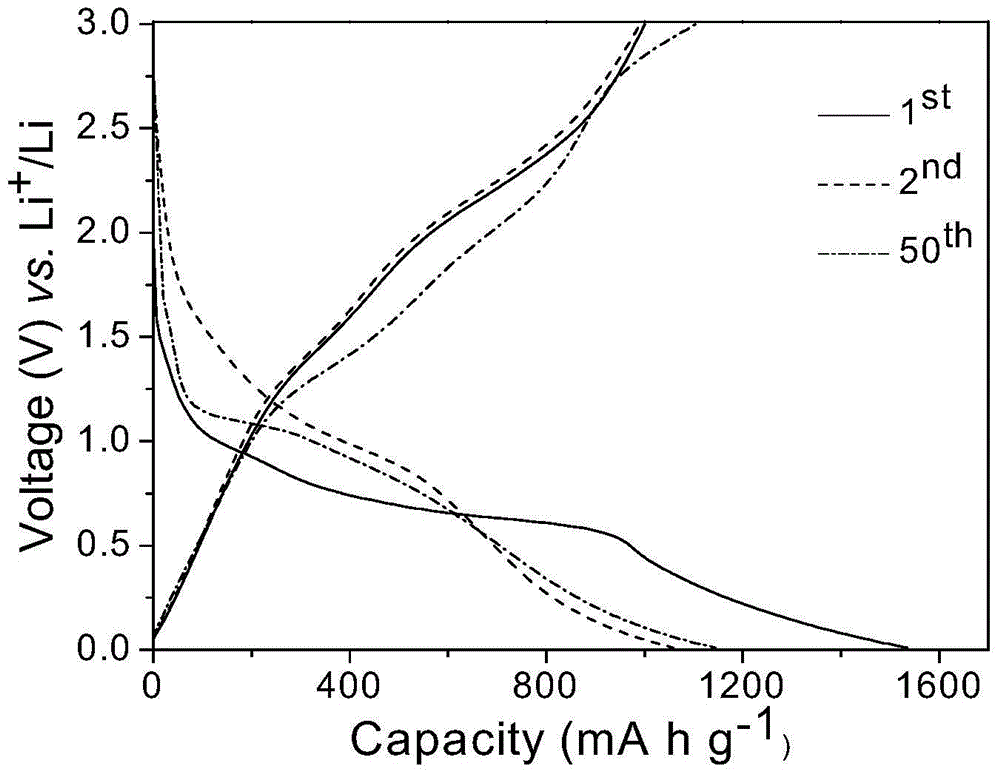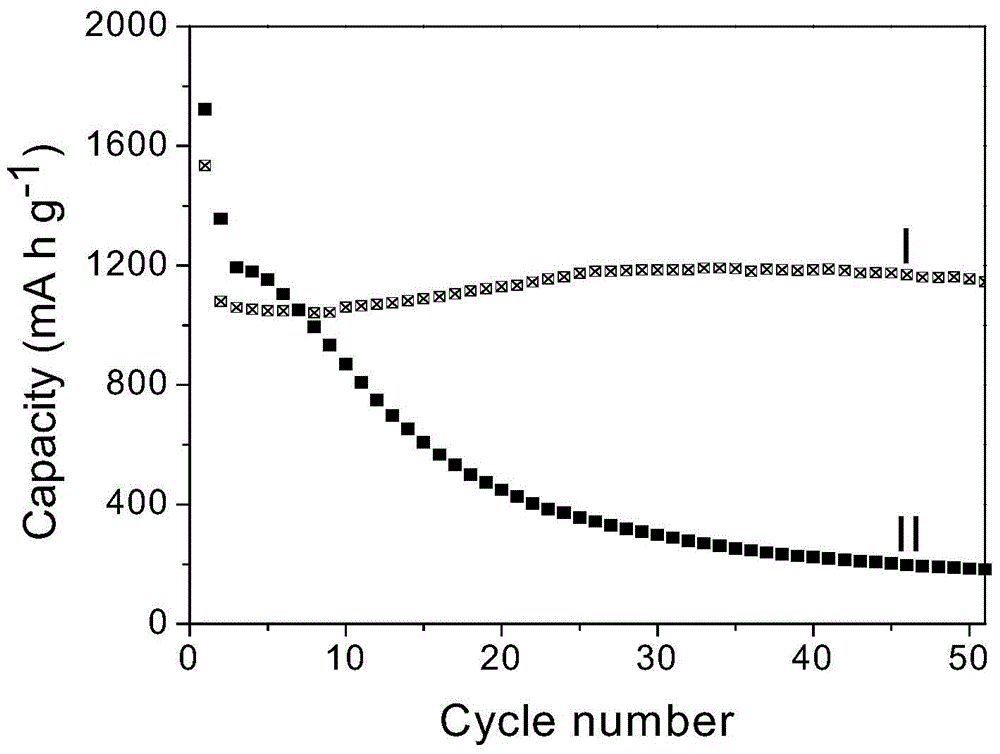Preparation method of metal oxide nanosheet and carbon nanotube composite energy storage material
A carbon nanotube composite and energy storage material technology, which is applied in the field of energy storage material preparation, can solve problems such as lack, and achieve the effects of good conductivity, improved electrochemical efficiency, and high capacity
- Summary
- Abstract
- Description
- Claims
- Application Information
AI Technical Summary
Problems solved by technology
Method used
Image
Examples
Embodiment 1
[0019] This embodiment includes the following steps:
[0020] The first step: Weigh 0.4 mg of carbon nanotubes with hydroxyl groups into a flask, add 60 mL of acetone, ultrasonically disperse for 5 minutes, then add 0.8 mg of maleic anhydride, and stir and react at 25 ° C for 10 hours to obtain modified carbon nanotubes, and washed 4 times with acetone;
[0021] Step 2: Weigh 0.127g of modified carbon nanotubes, add to 30mL of anhydrous toluene solution, ultrasonically disperse for 10 minutes, and record it as liquid A; add 80mg of azobisisobutylcyanide to 3.82g of styrene Inside, ultrasonic for 10 minutes, recorded as solution B; mix solution A and solution B, stir and react at 70°C for 7 hours under nitrogen atmosphere, to obtain carbon nanotubes modified with polystyrene layer, wash with ethanol 5 times;
[0022] Step 3: Weigh 30 mg of carbon nanotubes modified with a polystyrene layer, add them to 50 mL of concentrated sulfuric acid with a concentration of 98%, disperse u...
Embodiment 2
[0027] This embodiment includes the following steps:
[0028] Step 1: Weigh 2mg of carbon nanotubes with hydroxyl groups into a flask, add 300mL of acetone, ultrasonically disperse for 5 minutes, then add 4mg of maleic anhydride, stir and react at 25°C for 10 hours to obtain modified carbon nanotubes tube and washed 4 times with acetone;
[0029] Step 2: Weigh 0.635g of modified carbon nanotubes, add them to 150mL of anhydrous toluene solution, ultrasonically disperse for 10 minutes, and record it as liquid A; add 400mg of azobisisobutylcyanide to 19.1g of styrene Inside, ultrasonic for 10 minutes, recorded as solution B; mix solution A and solution B, stir and react at 70°C for 9 hours under a nitrogen atmosphere, to obtain carbon nanotubes modified with polystyrene layer, wash with ethanol 5 times;
[0030] Step 3: Weigh 150 mg of carbon nanotubes modified with polystyrene layer, add them to 200 mL of concentrated sulfuric acid with a concentration of 98%, ultrasonically di...
Embodiment 3
[0035] This embodiment includes the following steps:
[0036] The first step: Weigh 4 mg of carbon nanotubes with hydroxyl groups into a flask, add 500 mL of acetone, ultrasonically disperse for 10 minutes, then add 8 mg of maleic anhydride, and stir and react at 25 ° C for 10 hours to obtain modified carbon nanotubes tube and washed 4 times with acetone;
[0037] Step 2: Weigh 1.27g of modified carbon nanotubes, add them to 300mL of anhydrous toluene solution, ultrasonically disperse for 10 minutes, and record it as liquid A; add 800mg of azobisisobutylcyanide to 38.2g of styrene Inside, ultrasonic for 10 minutes, recorded as B solution; Mix A and B, stir and react at 70°C under nitrogen atmosphere for 10 hours, to obtain carbon nanotubes modified with polystyrene layer, wash with ethanol 5 times;
[0038] Step 3: Weigh 300 mg of carbon nanotubes modified with a polystyrene layer, add them to 500 mL of concentrated sulfuric acid with a concentration of 98%, ultrasonically di...
PUM
 Login to View More
Login to View More Abstract
Description
Claims
Application Information
 Login to View More
Login to View More - R&D
- Intellectual Property
- Life Sciences
- Materials
- Tech Scout
- Unparalleled Data Quality
- Higher Quality Content
- 60% Fewer Hallucinations
Browse by: Latest US Patents, China's latest patents, Technical Efficacy Thesaurus, Application Domain, Technology Topic, Popular Technical Reports.
© 2025 PatSnap. All rights reserved.Legal|Privacy policy|Modern Slavery Act Transparency Statement|Sitemap|About US| Contact US: help@patsnap.com



